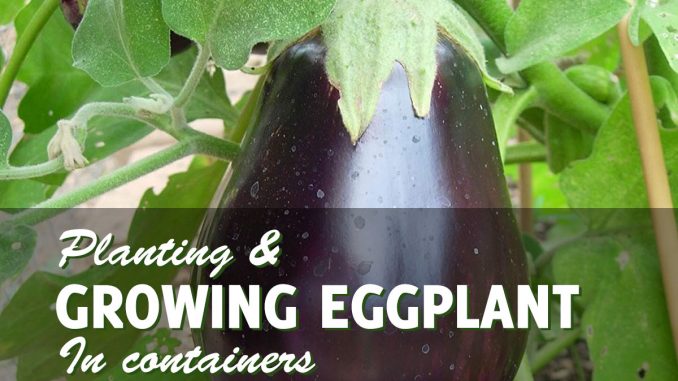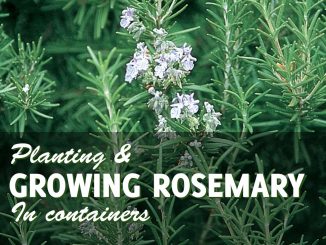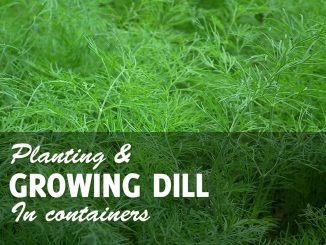
Growing eggplant in containers is a wonderful way to add more vegetables to your diet. Eggplants are hardy vegetables that you can quickly grow in your garden. The eggplant, related to the tomato, produce bushes that are up to five feet tall and have hairy, coarse foliage. The shape of the crops varies depending on variety; some produce globular shaped vegetables, while others produce 8-inch long cylindrical crops. Choose a variety according to your needs when growing eggplants in containers.
Before You Start Growing Eggplant in Containers
Varieties that can be perfect for container gardening are Dusty, Little Fingers, Casper, and Black Beauty. Eggplants are warm-weather crops and can be affected drastically by frosts. Schedule your planting when the danger of frost has finally ended. If you cannot wait, then start your cultivation indoors about eight weeks before you plan to transplant your crops outside. Small, empty containers or cut-out milk jugs can be used to create a type of localized greenhouse effect for seedlings. Outside temperatures should reach at least 64F at night when growing eggplant in containers.
Eggplants also need a lot of sun. Give your plants at least 6-8 hours of sunlight, preferably more for a healthier plant.
Choosing the Right Container to Grow Eggplant
There are different containers for you to choose for container gardening. You can use terracotta pots if your area is slightly colder. Plastic or wood containers are preferred for places that have warm weather as they hold in moisture remarkably well and help insulate the soil. Excessive heat can damage the soil, and this can quickly happen in container gardening. Another reason why plastics and wooden containers are advisable for growing eggplants in pots is that they do not absorb any water you give your plants.
A reason for failure in container gardening is inadequate moisture, so choose your pots well. It is advised to use a container that is around 3-5 gallons for growing eggplants. Dwarf varieties need at least an 8-inch deep window box for proper cultivation. Larger eggplants will need larger pots of 12 inches deep or more.
Maintain adequate drainage by drilling holes at the bottom of your containers. Others prefer drilling container holes located ¼ to ½ inch from the bottom. Line the bottom of your container with an inch of coarse gravel or small pieces of terracotta pots to promote drainage. You can use fiberglass mesh netting for this purpose, as well as to prevent pests from getting inside the pots.
Preparing Your Soil or Potting Mix
Your growing medium is essential for container gardening. Never use garden soil; it contains pathogens such as fungus, bacteria, and viruses that can harm your plant. Buy a potting mix from your local garden store for a better growing medium. Its composition is basically sterile or pasteurized soil, perlite, vermiculite, and compost for water retention and root growth.
There are also soilless potting mixes for growing eggplants in containers made up of perlite, vermiculite or sphagnum moss, but going they are used as a second option. You still need to mix in a reasonable amount of compost for further nourishment. You can even try slow-release fertilizers such as 15-15-15 or 10-15-10, although compost is still the preferred option.
Eggplants prefer a mildly acidic environment; therefore, you should adjust the soil’s pH to 6.3-6.8 using lime to increase pH or sulfur to decrease it. Mix the soil well and moisten it before you plant your seeds.
As much as possible, do not be cheap when buying a potting mix for your eggplant. A poor potting mix will hold and retain water, drowning your roots and cause damage to your crops
Growing Eggplant in Containers From Seed
Be sure to start seeds when temperatures reach 64F, which would typically be about late February or April. Planting when the soil is cold will shock the seeds and will delay the germination process.
Soak the seeds overnight to prepare them for planting. Place two seeds 3 inches apart in a container and cover with ¼ – ½ inch layer of compost. Lightly pat it on the seeds, but not too firmly and water them using a fine mist hose to prevent washing them out. If the weather is still a bit cool, insulate your seeds by placing an upside-down container that is big enough to cover the soil or the entire container.
Keep in a warm place and maintain a moist but not wet environment when growing eggplants in pots. Germination usually happens between 10-15 days if warm conditions are maintained. Once seedlings sprout, remove the least-healthy ones once they grow two true leaves.
Place the container several inches beneath a fluorescent light that is timed to stay on for 14-16 hours a day. Once the seedlings grow to 4-6 inches, place a stake to support your crops to keep them straight. Harden your seedlings for two weeks before moving them outside.
You can plant more than one eggplant in a large container; just make sure to consider a space of at least two feet between your plants when you do so.
Transplanting Eggplants in Containers
Transplants are best if you wish to plant eggplants immediately. With this type of start, you do not need to thin out your crops when planting. You can purchase cell packs or individual containers of eggplant transplants in your local nursery. Ask where your transplants were cultivated to know if you need to harden them off if you wish to grow them outside.
As with the seeds, moisten the soil and make sure it is warm before you place your transplants in when growing eggplants in containers. Transplants are also susceptible to frost, so make sure that you plant them once there is no more danger of frost in your area. Ideally, there should be just one transplant in one container.
If you have a large box, space plants 24 inches apart with 30-36 inches between rows. Handle your transplants with care as their roots are very delicate and dislike being disturbed. Dig a hole that is slightly bigger than the size of the container of your plant. Place about an inch of compost at the bottom and carefully set in your transplant. Cover with soil and an inch of compost or a half cup of slow-release fertilizer and then water.
Care and Harvest of Eggplant Grown in Containers
Caring for your eggplant is easy. Mulch your crops with compost or moss to keep in moisture and to ward off weeds. Give your plants slow-release fertilizer every three weeks according to package instructions. For more productive, healthier cultivation go organic by giving your eggplants a side-dress of aged compost manure and drizzle in good compost tea or organic liquid fertilizer every two weeks. Keep the foliage healthy and to keep out pests and disease by spraying your crops with compost tea every 3-4 days.
Harvesting usually comes 50-60 days, depending on the variety. Typically, your eggplants are ready once they reach 6-8 inches in size.
Observe your eggplants daily since they can easily change from a vibrant, deep, violet color to dull and brown. Vegetables of this condition are not suitable for consumption for they are spongy in texture and bitter in taste.
Be careful when harvesting as some varieties have thorns. Wear gloves when harvesting, and do not pull or twist the vegetables from the plant. You have to use a sharp knife or pruning shears to protect the stems. Leave the calyx attached to the fruit when you harvest.
Diseases and Pests You Have to Watch out for When Growing Eggplants in Containers
Prevent aphids by placing pots of garlic and chives near the eggplant.
Inspect the leaves daily and pick out caterpillars that will eat the leaves. Squash bugs can also be a major pest; if you have an infestation of them you may want to check out our article on neem oil for squash bugs. You can also prevent this by doing crop rotation.
Spider mites can be prevented by spraying the underside of leaves with water daily or compost tea. Be careful not to over-do it for dry leaves are essential for preventing powdery mildew.
Now that you are growing eggplant in containers you should plant a friend for it! Have a look at our guide on growing chives in pots!




Be the first to comment